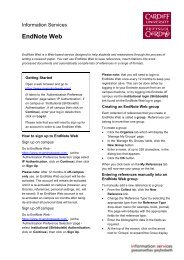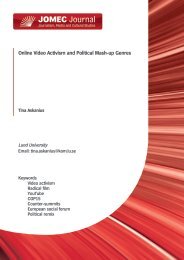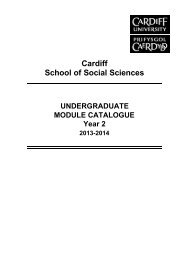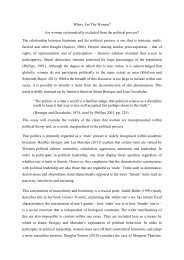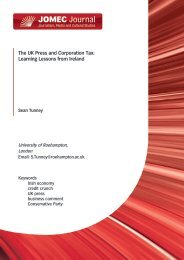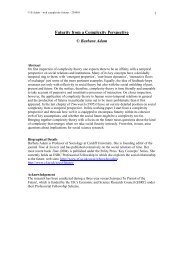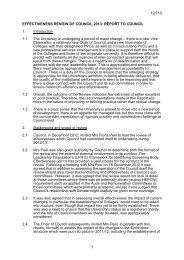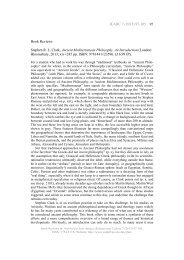APHRODITE IN PROCLUS' THEOLOGY - Cardiff University
APHRODITE IN PROCLUS' THEOLOGY - Cardiff University
APHRODITE IN PROCLUS' THEOLOGY - Cardiff University
You also want an ePaper? Increase the reach of your titles
YUMPU automatically turns print PDFs into web optimized ePapers that Google loves.
JLARC 3 (2009) 21-43 35<br />
Proclus provides further insights into the role of Aphrodite in the famous battle<br />
of the gods described in the Iliad. 54 War generally functions in tales as an image of<br />
cosmic disintegration and strife and this should also be the basis for the allegorical<br />
interpretation of this theomachy. The gods are arranged in five opposing pairs. Their<br />
disposition follows naturally from the Homeric text and therefore the positions held<br />
by Ares, Hephaestos, and Aphrodite depart from those presented in the exegesis<br />
of Hephaestos’ chains. Only Aphrodite, interestingly, is outside the decad.<br />
Here the pairs of opposites are analogous to the Neoplatonic hypostases of being,<br />
life, intellect, and soul, the latter seen as a discursive (Hermes) and an irrational<br />
structure (Leto), a sensible and corporal world where Hephaestos is nature, Xanthus<br />
the sensible order receiving forms. Aphrodite is below the decad, representing the<br />
connection of the whole demiurgy as a principle of harmony. Thus her opposite is<br />
the real demiurge, Zeus, who is only implicitely present in this picture. Another<br />
interesting feature of Aphrodite in this passage is that Homer, according to Proclus’<br />
explanation, sets Aphrodite apart in order for her to illuminate all things with<br />
unification and harmony, but especially in order to come to the assistance of the<br />
weaker party, because in them plurality dominates unity. 55 Proclus points out that<br />
every opposition is correctly understood only in its connection with unity. But it is<br />
interesting that the difference between unity, pre-existing in its cause, and unity as<br />
harmony of the parts, is expressed here as a theological relation between the (only<br />
implicitely present) Zeus and Aphrodite.<br />
To this aspect refers also the only mentioning of Aphrodite in the Commentary<br />
on Parmenides where Proclus says that if we ascend to the gods from the realm of<br />
numbers, the hexad is sacred to Aphrodite and the heptad to Athena. “The heptad<br />
of Athena is unifying, and Aphrodite’s hexad safeguards plurality in company with<br />
communion.” 56<br />
Aphrodite as helper of the weak also comes surfaces in those passages of the<br />
Commentary on the Republic which complement the Proclean exegesis of the<br />
theomachy. 57 Proclus is here particularly interested in the confrontation between<br />
Hephaestos and Xanthus. In physical opposition between bodies Hephaestos represents<br />
heat and dryness, Xanthus cold and wetness:<br />
In Remp. 1.95,22-26:. ἐπεὶ δὲ πάσας ἀνάγκη τὰς ἐναντιώσεις εἰς τὴν πρὸς ἀλλήλας<br />
ὁμολογίαν τελευτᾶν, πάρεστι καὶ ἡ Ἀφροδίτη, καθάπερ εἴπομεν, φιλίαν ἐμποιοῦσα<br />
τοῖς ἀντικειμένοις, συμμαχοῦσα δὲ ὅμως τοῖς χείροσιν, διότι καὶ ταῦτα μάλιστα<br />
κοσμεῖται σύμμετρα καὶ προσήγορα γινόμενα τοῖς ἀμείνοσι τῶν ἐναντίων.<br />
And because every opposition is necessarily destined to end in mutual harmony<br />
Aphrodite is also here. Aphrodite establishes amity between the opposites, but she<br />
54 In Tim. 1.78,27-80,5.<br />
55 In Tim. 1.79.16-19.<br />
56<br />
In Parm. 768,8. This translation of Morrow and Dillon is from Glenn R. Morrow and John<br />
M. Dillon, Proclus. Commentary on Plato’s Parmenides (Princeton, 1987).<br />
57 In Remp. 1.95,18-95,30.<br />
Tuomo Lankila, ‘Aphrodite in Proclus’ Theology,’ in: Journal for Late Antique Religion and<br />
Culture 3 (2009) 21-43; ISSN: 1754-517X; Website: http://www.cardiff.ac.uk/clarc/jlarc



